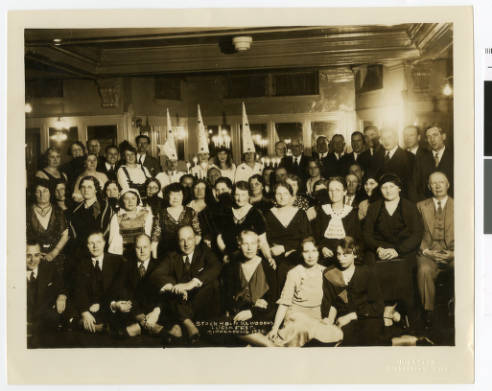
This week, Minneapolitans are celebrating two festivals of light.
This Saturday, Scandinavians observed Santa Lucia Day. This holiday features a girl–and in recent years increasingly a boy–who portrays Lucia, the saint credited with bringing hope and salvation to the starving masses at a time of crisis in the Middle Ages. Dressed in a long white gown with a red sash with a crown of candles, modern-day Lucias walk at the head of singing procession. The ceremony signals the beginning of the Christmas season and the triumph of light over darkness at a time of year when nights are almost uninterrupted in Scandinavia. In Sweden, the country that embraces this holiday most enthusiastically, every school and town has a Lucia procession. In private homes, children bring Lucia buns and coffee to their parents first thing in the morning.
Here in Minneapolis, Swedish Americans have marked this holiday with celebrations at the American Swedish Institute like the one shown here in 1932. This photo shows members of the Stockholm Club gathered at ASI to honor the young woman they choose as Lucia. This Lucia–whose real name was not recorded–is at the center in the rear of this photo. She has a crown of candles and is surrounded by her star boys, who are wearing the traditional peaked hats.
Last night marked the beginning of Hanukah, the eight day Jewish festival that also celebrates the triumph of light over darkness. All over the world Jews lit the first of eight candles in their menorahs, which serve as a reminder of a miracle in the Holy Temple of Jerusalem more than 2,000 years ago. After a group of orthodox Jews defeated an army of Greeks, they sought to re-ignite that temple’s Menorah. While they only had enough oil for one day, in a wondrous turn of events, this supply lasted for eight days. The festival of Hannukah commemorates this miracle. While Hanukkah is a relatively minor holiday for Jews, its proximity to Christmas has given it new significance in the United States, where many non-Jews have come to see it as a “Jewish Christmas.”
In Minneapolis during the 1950s, Jews became increasingly visible as the city sought to erase its reputation as the American “Capital of Anti-Semitism.” This title had been bestowed in 1946 on the city by journalist Carey McWilliams, who was appalled to observe the level of social ostracism endured by Jews in the city. Under the leadership of mayor Hubert Humphrey, city leaders resolved to demonstrate their determination to combat prejudice. The city won national acclaim for its Fair Employment Practices Commission, which was established in 1948 to investigate complaints of discrimination.
This 1953 photo seems to illuminate that these efforts went beyond legal measures. It shows two members of the Minneapolis Chamber of Commerce presenting Edith Linhoff with a prize for the Hanukkah decorations in her home (which seemed to include an oversized menorah and an enormous dreidel). The photo makes me wonder whether this award was part of the broader civic initiative to make Minneapolis more welcoming to Jews.
The first photo is from the collections of the American Swedish Institute and comes to Historyapolis via the Minnesota Digital Library. The second photo is from the Sharron and Oren Steinfeldt Photography Collection at the Nathan and Theresa Berman Upper Midwest Jewish Archives at the University of Minnesota. Thanks to all of these organizations for their generous use policies.
